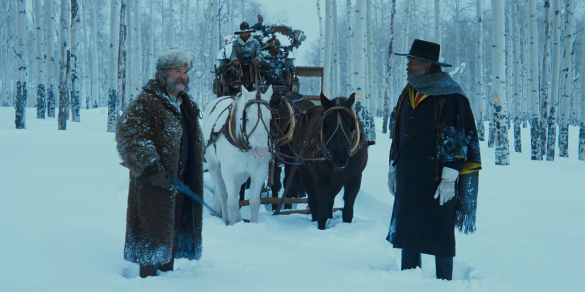
If you haven’t noticed, we live in times where technology has seen a huge boom. Our phones and TVs are smart, pirating isn’t what it used to mean, and the average joe can make it big by recording a cat trying to fit into the tiniest boxes (seriously though, it’s too adorable to avoid).
Movie theaters have changed too. Most films are no longer shot and shown on film, it’s all digital. No longer do we get to hear the clickity-clicking of the film through the projector. It’s unfortunately a dying format that only a few filmmakers actually care about. Thankfully, Tarantino can be counted as one of the few who does care, which he so lovingly shows through The Hateful Eight 70mm Roadshow.
What is a Roadshow?
Why, that’s a great question! Roadshows special, limited screenings of movies back in the 50’s and 60’s. Essentially, it’s like seeing a play, but instead, you’re seeing a movie! The roadshow version of a film would likely show a longer edit than the theatrical version that would arrive in the rest of the theaters around the world, giving those who choose to see the roadshow a little more bang for their buck. Continuing with the thought that it’s treated as a play, audience members are handed a program before they enter the theater and are welcomed by an on-screen overture as they take their seats. The film would also have an intermission, letting the audience members leave the theater to discuss about what they’ve seen, contemplate on what they’ll see next, or catch a quick bathroom break before starting the second act. It was a way that made seeing now classics like The Sound of Music, Laurence of Arabia, and Ben-Hur a richer experience.
So how does The Hateful Eight Roadshow Experience compare?
Hell if I know! Obviously, I wasn’t around during the 50’s and 60’s, but the amount of time and dedication Tarantino put into the idea of bringing back the roadshow for The Hateful Eight is apparent from the get-go.
Ultra Panavision 70

First of all, Tarantino filmed the entire film in Ultra Panavision 70, a type of camera that hasn’t been used in almost fifty years. The camera’s film provide an aspect ratio of 2.76:1 than the aspect ratio of 1.85:1 or 2.39:1 that we see today in theaters digitally. Yes, I know; On paper, that sounds like gibberish, but when you see what the Ultra Panavision 70 can do, the difference is apparent and It. Is. Glorious.
The Hateful Eight Program

photo: theverge.com
The program prepared for the roadshow is filled with large, colorful on-screen and off-screen images as well as character descriptions, and details as to why they chose to bring back the roadshow experience. All-in-all, the program was well put together and definitely makes a great souvenir to take home.

Photo: denofgeek.us
The Overture
The overture that greets the audience as they take their seats provides a great setting for the film, a moody, foreboding tune that really sinks under your skin and lets you wonder what you’re about to experience. Listen to the overture here.
The film itself was fantastic, the first act slow build up (though not in a negative way) to an explosive second act. We knew Tarantino could pull of westerns via Django, but this western/whodunit hybrid is something fresh to gaze on. Just like the overture, the rest of the soundtrack by Ennio Morricone was engrossing; a haunting fit to the films genre mash-up. The show stealer, however, goes to Jennifer Jason Leigh in her portrayal of Daisy Domergue, the dirty-mouthed fugitive whom the story centers around. Leigh provides a give-no-fucks feel to her character that makes the audience question when and on whom she’s going to snap.

The Takeaway
The roadshow experience for The Hateful Eight isn’t something to take for granted. This is something that hasn’t happened in almost fifty years, and who knows when another film will be shot with an Ultra Panavision 70. Do yourself a favor: Find a theater that’s hosting a roadshow in your area, get your ass in a seat, and experience what may be the last opportunity on such a cherished form of cinema.